Morlaix en Bretagne
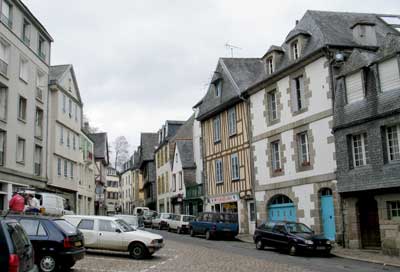
We have done only a little bit of touring since arriving in Brittany. Earlier this week we drove toward the west to the city of Morlaix. Set in a deep valley, Morlaix has a well-pr
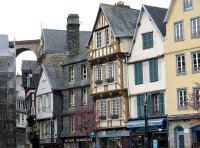 eserved core of late medieval houses (left & right). We have a lot to learn about Brittany’s history, but it is clear that Brittany had a golden age that began around 1350 and lasted into the 1500s. As a peninsula with many bays that could harbor ships, Brittany has a long history of seafaring, commercial fishing, and shipbuilding. Morlaix participated in the maritime trades and also was an important center of linen production and tobacco processing. Morlaix is in the area of Brittany known as Finistère (literally “land’s end). Finistère lies just across the channel from England and so has been militarily important as well as being heavily involved in smuggling and piracy. The largest city in Finistère is the port of Brest; Morlaix has a population of about 18,000.
eserved core of late medieval houses (left & right). We have a lot to learn about Brittany’s history, but it is clear that Brittany had a golden age that began around 1350 and lasted into the 1500s. As a peninsula with many bays that could harbor ships, Brittany has a long history of seafaring, commercial fishing, and shipbuilding. Morlaix participated in the maritime trades and also was an important center of linen production and tobacco processing. Morlaix is in the area of Brittany known as Finistère (literally “land’s end). Finistère lies just across the channel from England and so has been militarily important as well as being heavily involved in smuggling and piracy. The largest city in Finistère is the port of Brest; Morlaix has a population of about 18,000. 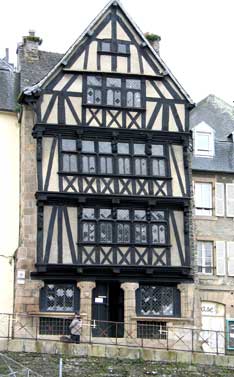
A unique house form, the pontalez house, developed in Morlaix. Pontalez is a variant of pont allez or “bridge access,” which refers to a peculiar form of staircase and balcony. This is a bit difficult to describe, but I will do my best. The pon
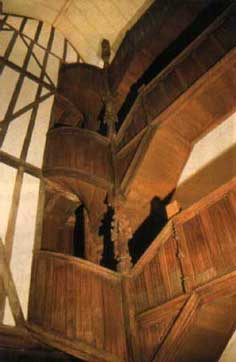 talez house is a town house of 3 or 4 stories, narrow across its front, but extending quite far back. In the center of the house is a grand hall that rises all the way to the roof. The two side walls of the house are of stone, with a large hearth on one side of the central hall. On the opposite side is a spiral staircase of wood, providing access to wooden balconies, or bridges (ponts) that lead to a tier of rooms at the front and at the back of the house. Th
talez house is a town house of 3 or 4 stories, narrow across its front, but extending quite far back. In the center of the house is a grand hall that rises all the way to the roof. The two side walls of the house are of stone, with a large hearth on one side of the central hall. On the opposite side is a spiral staircase of wood, providing access to wooden balconies, or bridges (ponts) that lead to a tier of rooms at the front and at the back of the house. Th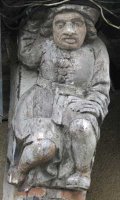 e fronts of the pontalez houses are half-timbered, with the upper floors often projecting out a bit over the lower ones. Commonly, statues of wood and stone decorated the facades. Some of the old houses in the cities of Brittany have facades of slate, something I have not seen elsewhere. Many of Morlaix’s houses have businesses on the main floor, making for a somewhat jarring contrast between street level and the view above. We enjoyed walking around the city on a gray afternoon and going into one of the pontalez houses.
e fronts of the pontalez houses are half-timbered, with the upper floors often projecting out a bit over the lower ones. Commonly, statues of wood and stone decorated the facades. Some of the old houses in the cities of Brittany have facades of slate, something I have not seen elsewhere. Many of Morlaix’s houses have businesses on the main floor, making for a somewhat jarring contrast between street level and the view above. We enjoyed walking around the city on a gray afternoon and going into one of the pontalez houses. In the 1860s, the railroad came to Morlaix, and a huge stone via
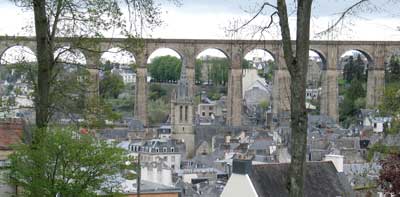 duct was built to carry the railway across the deep valley. This two-tiered viaduct (obviously based on Roman models) has become a symbol of the city. The city’s motto—s’ils te mordent, mords les!—is also notable. The translation is “if they bite you, bite ‘em back!”
duct was built to carry the railway across the deep valley. This two-tiered viaduct (obviously based on Roman models) has become a symbol of the city. The city’s motto—s’ils te mordent, mords les!—is also notable. The translation is “if they bite you, bite ‘em back!”
Teebie (that's Tibi in French) is making himself quite at home here in France. He has taken quite a shine to Christy and likes nothing more than sitting on her lap when she is at the computer. Here he is waiting patiently for her return, or perhaps trying to log onto a web site where he can meet French dogs. Teebie, along with most everyone else hereabouts, feels that spring has yet to fully establish herself and he longs for more sunshine.
I am just beginning to think seriously about my project of making a catalogue of the library at the Chateau de Kerivon. The library is a wonderland for a bibliophile, with perhaps 3,000 leather-bound volumes housed in wall cupboards. The room is at the center of the second floor of the chateau, paneled in wood painted light green. The books date mainly to the 18th century. The collection includes all of the classic French writers--Racine, Corneille, Moliere, Boileau, La Fontaine, Rousseau, Buffon--many histories of Brittany and France,
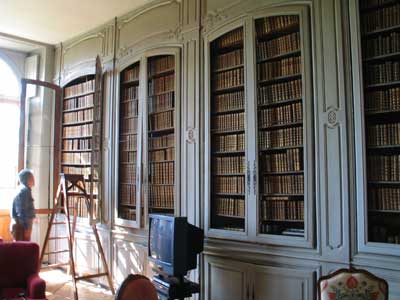 theology and sermon collections, translations of Greek and Roman authors, novels, memoirs of voyages of discovery (Captains Cook and Bougainville), and much more that I have yet to discover. It will be a labor of love to make the catalog of the collection.
theology and sermon collections, translations of Greek and Roman authors, novels, memoirs of voyages of discovery (Captains Cook and Bougainville), and much more that I have yet to discover. It will be a labor of love to make the catalog of the collection.On Friday we are heading to Nîmes and Aix-en-Provence for a two-week conversational French course and to view the traces of the Roman presence in Nîmes. Before that, we will spend a couple of days on the southern coast of Brittany, most particularly looking at the prehistoric site at Carnac, which has some three thousand menhirs (standing stones) erected more than 6,000 years ago. Christy has been a wonderful host, but understandably we are looking forward to being in our own place once we return from the South on May 20.

1 Comments:
I'm checking in to see how it's going. I'm enjoying the vicarious tourism.
Hope you both are well.
Post a Comment
<< Home